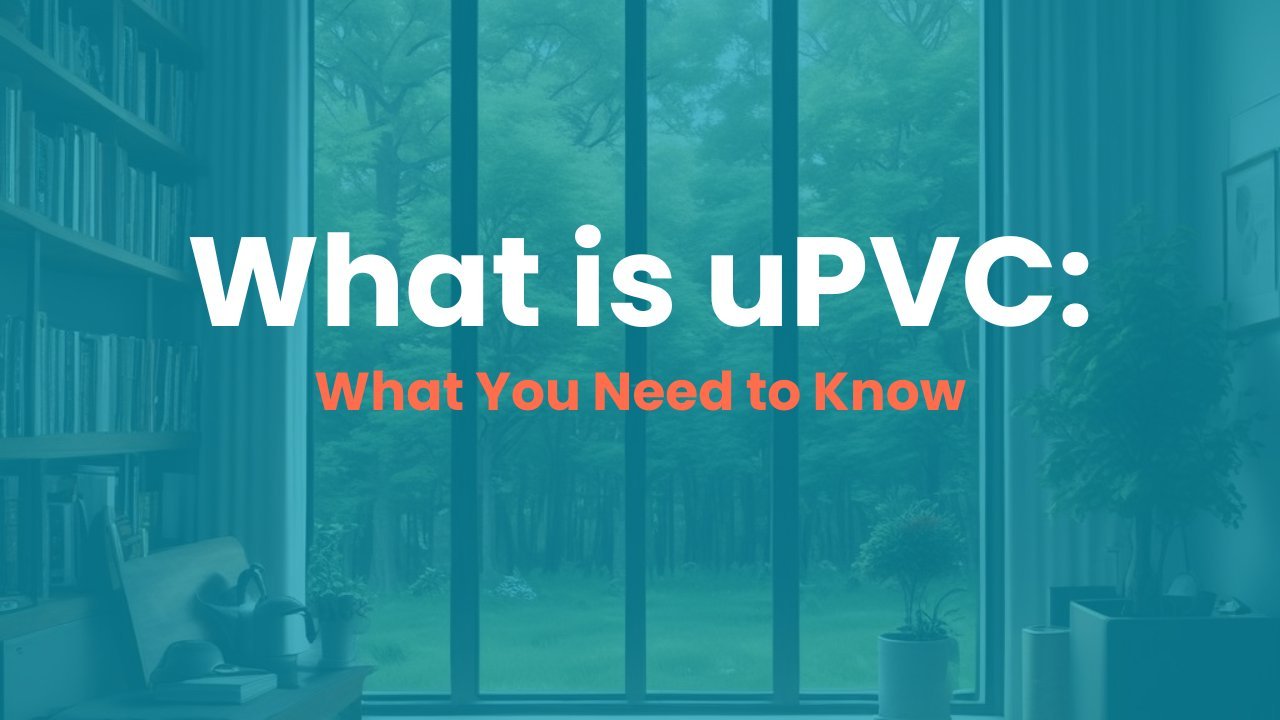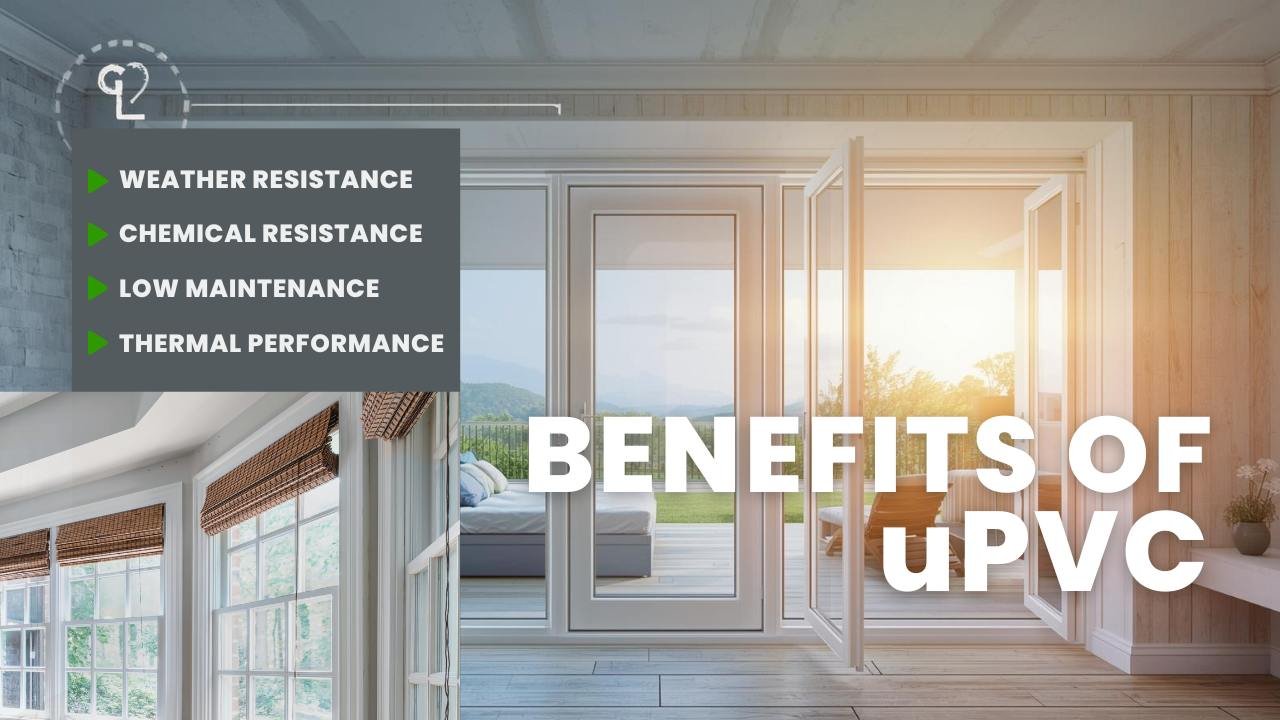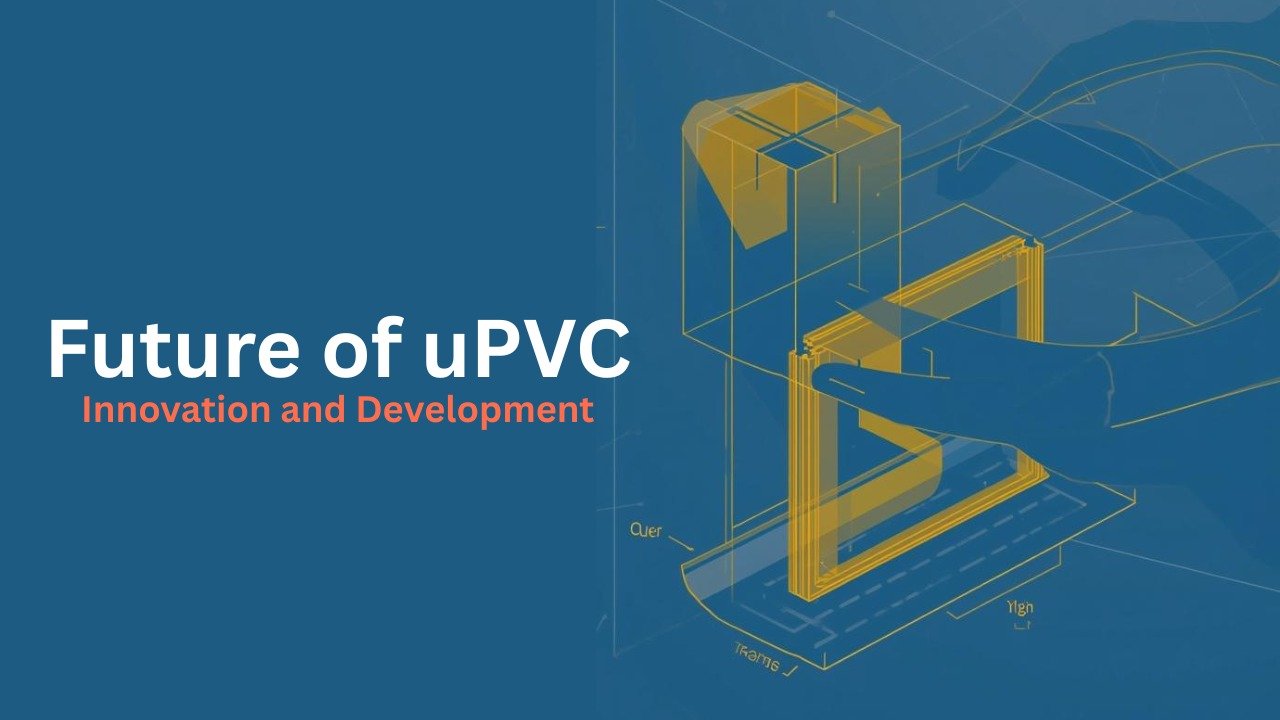What is uPVC: What You Need to Know

uPVC (Unplasticised Polyvinyl Chloride) is just a more rigid, tougher version of standard PVC plastic, minus any plasticizers, meaning it is very rigid and weather-resistant. uPVC, unlike flexible PVC found in hoses or wet-weather gear, will not twist or bend, warp, or crack in normal conditions. For this reason, uPVC is a great choice for construction-related applications where windows, door, and roofing are involved. The real benefit of uPVC is its remarkable longevity and little required maintenance: those white shining window frames and doors will stay looking new for decades with no painting or extra added treatments. This strength is also supported with excellent weather resistance from the rain, sun, high temperature to even low temperature. What is uPVC definitely is the go-to choice for a homeowner, architect, or builder who want a reliable product that not only performs well but that has good styling, and can last with virtually no upkeep.
Manufacturing Process: From Raw Materials to Finished Product
The characteristics of uPVC starts with the basic material vinyl chloride monomer, which undergoes polymerization to produce PVC resin (generally a white powder) as the base material. The PVC resin will not contain the same strength and durability of finished What is uPVC products, so the PVC resin is carefully formulated with other materials called additives, in this case, A fine powder of calcium carbonate adds stiffness, titanium dioxide provides the bright white color matched together with something for sun protection, impact modifiers avoid cracking, and processing aids allow the manufacturer to make things easier. This blending process is what gives What is uPVC its longevity and resilience to wet weather conditions.
The blended compound proceeds to the extrusion stage. Think of it like squeezing toothpaste from a tube, but on a much larger industrial setting and at approximately 200 degrees Celsius. The softened compound is forced through highly engineered dies made from a precision steel to produce specific profiles for windows, doors and other applications. Each exiting profile is cut, welded or drilled to its finished profile near 100 percent accuracy, sometimes within fractions of a millimeter. That is why there are quality checkpoints at every step of the production process that are monitored for strength, long-term durability and wet weather ratings, so building products made from What is uPVC remain one of the most dependable building materials next to steel.
Benefits of uPVC

What is uPVC’s secret to success? It’s a unique blend of properties that is hard to come by in any one other material. Let me explain the properties that make uPVC door market in India popular with builders and homeowners alike.
1. Weather Resistance: Built to Last
The wonderful thing about What is uPVC is the ability withstand whatever Mother Nature throws at it. Unlike wood, which can rot, warp, and crack if left wet, uPVC does not suffer from exposure to rain, snow, or damp. The uv resistance of the material is also remarkable. Most plastics become brittle and discolored with prolonged exposure to sunlight, well-formulated uPVC remains strong and looks good for decades. The uv stability is achieved with proper choice of additives during manufacture.
Temperature changes that would cause other materials contraction and expansion have little influence on What is uPVC. The coefficient of thermal expansion of the material is relatively low, and it is dimensionally stable over a large temperature range.
2. Chemical Resistance: Practically Indestructible
Another feature of uPVC is its chemical innocuousness. What is uPVC is resistant to acids and alkali’s and highly resistant to use in most general chemicals. This means uPVC surfaces will not be eroded or damaged by pollution, acid rain or cleaning chemicals.
I remember talking with a facility manager at a chemical plant, when he informed me that after 20 years of exposure to industrial fumes there was no degradation to the OUTSIDE of their uPVC windows. Try that with a metal frame and you would see corrosion within a few years.
3. Low Maintenance: Set It and Forget It
Perhaps the biggest advantage of What is uPVC, when asked of a resident, is extremely low maintenance. Wooden frame windows often need re-painting, sanding, treatment, and inspection over their lifetimes, where uPVC’s only requirement, aside from general cleaning with soap and water, is periodic inspection as needed.
Low maintenance is not merely about convenience – it represents significant budget savings too. Factoring in the cost of paint, labor, and the time spent maintaining existing materials – in many cases, What is uPVC’s cost of materials usually pays for itself within a few years.
4. Thermal Performance: Reducing Energy Bills
What is uPVC’s heat properties make it highly energy efficient. The uPVC itself is a relatively poor conductor of heat and doesn’t transfer thermal energy easily from inside to outside a building. Combined with contemporary double or triple glazing, uPVC window systems can provide very good insulation values.
Multi-chamber profiles, with multiple air-filled cavities within the uPVC framework, further improve thermal efficiency. These chambers serve as supplementary layers of insulation, minimizing the passage of heat and enabling comfortable interior temperatures during all seasons.
Common Applications: Where You'll Find uPVC

1. Windows and Doors: The Primary Market
uPVC typically has the association of windows, and that’s quite understandable, as this is the largest application for uPVC material, across the Globe. What is uPVC window?, As window frames, uPVC has durable, is weather resistant, low maintenance, and has great thermal performance. Nearly all uPVC bay window systems (replacement) can accommodate anything from standard double glazing, to triple glazed units with special coatings, and cut to specific sizes and designs, for domestic or commercial projects.
uPVC Doors have also started to be very popular, especially across Europe and Asia. The variety of doors that can be made from what is uPVC doors includes front doors, patio doors, and French doors. uPVC doors provide excellent security and thermal properties, and are weather tight. They can be textured or finished as wood grain and many other designs, giving homeowners the perfect combination of aesthetics, strength, and performance.
2. Roofing and Cladding: Protecting Buildings
Due to uPVC’s superior weather resistance, it is ideal for outdoor applications like roofing and wall cladding. What is uPVC roof tiles and sheets are an ideal solution for a light-weight, reliable alternative to clay or concrete tiles that are also less prone to algae and moss growth, helping the roofs look and perform better for longer.
In conjunction with exterior wall cladding, uPVC provides long-lasting weather protection and maintenance-free performance. With an incredible range of colors and surfaces available, it allows architects and builders to achieve the artistic vision they have without compromising on performance, making uPVC cladding a practical and modern option.
3. Guttering and Drainage: Water Flow Management
uPVC is now the preferred material for guttering and downpipe systems over cast iron and other traditional materials. Its lightweight nature makes installation easier and reduces the load on the building structure. What is uPVC has a smooth internal flow surface, resulting in good water flow. It is also a stable molecule and chemically resistant, which ensures good performance carrying acidic rainwater over the long run.
Unlike metal guttering systems, uPVC will not corrode or rust. This is important in coastal environments where sea salt evaporates into the atmosphere before being dislodged and causes components made of metals to corrode and deteriorate rapidly. The systems will also absorb impact load and allow thermal movement in the building without cracking and breaking What is uPVC systems.
4. Applications to Fencing and Gardens
What is uPVC fencing is increasingly becoming more prevalent, especially in applications where low maintenance is needed. Unlike wooden fencing which requires staining or reprinting every so often, uPVC fencing looks great with very little maintenance.
The resistance of the material to insects and rot makes it especially suitable for use in your garden. What is uPVC will provide no sustenance for termites or other insects and will not rot by being in contact with soil or moisture.
Potential Drawbacks: Understanding the Limitations
Although uPVC has many significant benefits, it is also needed to understand its fundamental limitations so that you can have a more informed decision about when and where you might want to use the material.
1. Aesthetic Issues: What is uPVC is unable to mimic the aesthetic values associated with natural wood or metals (steel or aluminum), as most people will prefer the appearance of the original materials. Moreover, the necessary thickness in the profile for a reliable structural performance appears quite thick when compared to a slim achievement with steel or aluminum frames.
2. Thermal Expansion Concern: While uPVC thermal expansion is lower than metals, it is still higher than wood and masonry materials. For long installations or extreme range of temperature conditions, proper design references for the thermal movement is required. If thermal movement is not considered in design, structural damage or failure can happen during use.
3. Color Stability Concern: All colors fade over time, even white. Although, modern formulations of uPVC have UV stabilizers, in extreme sunlight over time, dark colors fade more than light colors. White and light grey will typically provide the greatest long-term stability than darker colors.
4. Repair Consideration: Unlike wood, which can be easily repaired or refinished in-situation, this typically requires specialized methodology to repair or replaces the entire component after thermally degrading, although this repair is rarely required as uPVC is long-lasting.
What is uPVC Compared to Other Materials:
It is clearer when we consider the direct comparison with other materials that are typically used in the same applications of What is uPVC.
1. uPVC vs Wood
Wood has been the go-to building material for humanity for thousands of years, and it has innate beauty, good insulation capacities. However, wood requires regular maintenance, it is susceptible to rot and pest infestation, and it bends or twists with age.
What is uPVC much better weathering properties and almost zero maintenance. It may not closely replicate the aesthetic of wood, but some modern it comes pretty close to wood grain patterns and colors. Performance-wise, it usually surpasses wood in regard to thermal efficiency, particularly when comparing contemporary systems to historic wooden frame building systems.
2. uPVC vs Aluminum
Aluminum frames are robust, thin, and can be finished in almost any color. Aluminum is also a very good heat conductor, so it is less ideal for energy-efficient schemes where there are no thermal breaks.
uPVC’s high insulation properties grant it an overwhelming advantage for use in energy efficiency schemes. But aluminum’s strength enables bigger spans and thinner sight lines, which can be desirable in commercial building use or modern residential design.
3. uPVC vs Steel
Steel provides outstanding strength and security, with very thin profiles and extensive glazed areas possible. Steel must, however, be regularly maintained to avoid corrosion and provides poor thermal performance without substantial thermal break systems.
What is uPVC better against corrosion and in thermal performance, although it cannot compete with steel’s structural ability for very large schemes.
4. uPVC vs Composite Materials
Contemporary composite products try to marry the best qualities of a variety of materials – say, wood fibers with plastic matrices for weatherproofing. Composites have the potential to provide good performance, but they tend to be pricier than this and can require more complicated maintenance.
The established record, lower price, and widespread recycling networks of What is uPVC provide it with strengths over newer composite products in most uses.
Future of uPVC: Innovation and Development

The uPVC market is constantly advancing, with research and development both seeking to improve performance and respond to environmental issues.
1. Improved Formulations
Manufacturers are formulating novel additive packages that offer even higher UV stability, impact strength, and thermal stability. New formulations may incorporate bio-based additives, lowering the dependence on petrochemical-based additives.
2. Better Recycling Technologies
New recycling technologies are facilitating easier processing of post-consumer waste into high-quality products. Some manufacturers now provide products with high percentages of recycled content without sacrificing performance.
3. Smart Integration
Smart technology is increasingly being integrated into uPVC door and uPVC bay window systems. Air quality sensors, security systems, and motorized opening systems are all being integrated into uPVC frames.
4. Aesthetic Developments
New production methods are making possible even more realistic wood grain finishes and greater color variety. A number of manufacturers are creating What is uPVC products that are almost impossible to distinguish from high-quality wood types.
Making the Right Decision: Is uPVC Suitable for You?
Having discussed what is uPVC, its characteristics, uses, and issues, now you’re likely asking yourself if it’s appropriate for your particular needs. The response is based on some specific factors in your case.
1. Think About Your Priorities
If low maintenance and long-term durability are your top priority, this can’t be beaten. The weather-resistance, pest-resistance, and degradation-resistance of the material make it the ideal choice for time-constrained homeowners or commercial use where budgets for maintenance are constrained.
If aesthetic authenticity is of the utmost concern – perhaps for a heritage restoration exercise – then traditional materials may be the better choice, even though they do require greater maintenance.
2. Assess Your Environment
uPVC is very effective in most climates but, depending on conditions, may need special attention. Where very high UV or extreme temperature variations are present, liaising with manufacturers who have experience of such conditions is essential.
3. Budget Considerations
Whereas uPVC can be more expensive to install than some options, the long-term value proposition is frequently better if cost of maintenance and replacement is taken into account. Compare total lifecycle expense rather than individual cost when comparing.
4. Future Needs
Think about how your requirements could differ in the future. its durability ensures it will endure longer than other materials, but its modifiability difficulty may be something you’d need to consider if you foresee changes in the future for your building.
Conclusion: uPVC's Place in Modern Construction
uPVC (Unplasticized Polyvinyl Chloride) is an inexpensive, low maintenance, energy-efficient, long-lasting building material that is very popular globally. It was first manufactured in Europe after the 2nd World War and has since been used enormously for doors, windows, and other products because it is recyclable, weatherproof and retains heat. Buying products from reputable manufacturers and installers can benefit most projects greatly, even though it cannot be used with all design aesthetics. While advances have and will continue to enhance technology and sustainability; uPVC will remain a versatile, low-cost and sustainable building material for use in homes and businesses.
Frequenty Asked Questions
1. What does uPVC stand for and what is it made of?
uPVC stands for Unplasticized Polyvinyl Chloride. It’s made from PVC resin (derived from petroleum) combined with various additives like calcium carbonate for strength, titanium dioxide for UV protection, and impact modifiers for durability. Unlike regular PVC, no plasticizers are added, making it rigid and suitable for structural applications like windows and doors.
2. How long do uPVC windows and doors last?
High-quality uPVC windows and doors typically last 40-50 years with proper installation and minimal maintenance. This is significantly longer than wooden frames (15-20 years) and comparable to aluminum systems. The actual lifespan depends on the quality of materials, manufacturing standards, installation quality, and environmental conditions.
3. Do uPVC windows require maintenance?
uPVC windows require very little maintenance compared to other materials. They only need occasional cleaning with soap and water, and periodic checks of seals and hardware. Unlike wood, they don’t need painting, staining, or weather treatment. The hinges and locks may need occasional lubrication, but this is minimal compared to traditional materials.
4. Are uPVC windows energy efficient?
Yes, uPVC windows are highly energy efficient. The material has low thermal conductivity, and modern uPVC frames feature multi-chamber designs that provide excellent insulation. When combined with double or triple glazing, uPVC windows can achieve U-values as low as 0.8 W/m²K, significantly reducing heating and cooling costs.
5. Can uPVC windows be painted or changed color?
While uPVC can technically be painted with specialized paints, it’s not recommended as it can void warranties and may not adhere properly long-term. Instead, uPVC is available in various colors and finishes during manufacturing, including white, cream, brown, grey, and wood-grain effects. It’s better to choose the desired color upfront rather than paint later.